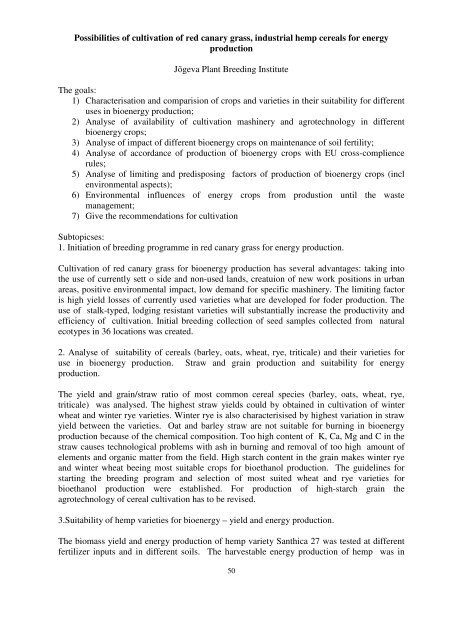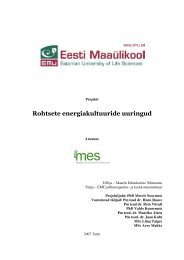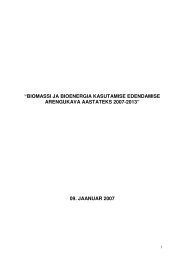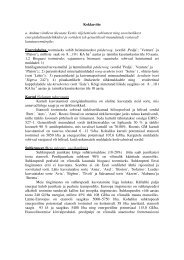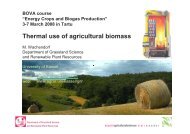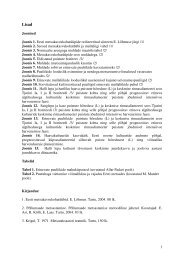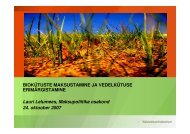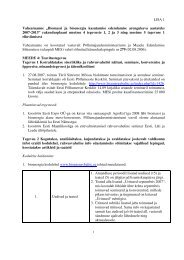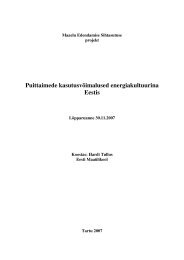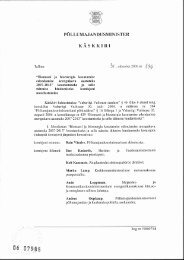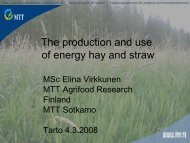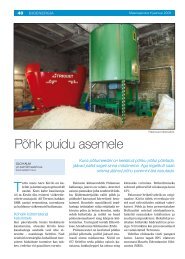Põllumajandusministeeriumi ja Maaelu ... - bioenergybaltic
Põllumajandusministeeriumi ja Maaelu ... - bioenergybaltic
Põllumajandusministeeriumi ja Maaelu ... - bioenergybaltic
Create successful ePaper yourself
Turn your PDF publications into a flip-book with our unique Google optimized e-Paper software.
Possibilities of cultivation of red canary grass, industrial hemp cereals for energy<br />
production<br />
Jõgeva Plant Breeding Institute<br />
The goals:<br />
1) Characterisation and comparision of crops and varieties in their suitability for different<br />
uses in bioenergy production;<br />
2) Analyse of availability of cultivation mashinery and agrotechnology in different<br />
bioenergy crops;<br />
3) Analyse of impact of different bioenergy crops on maintenance of soil fertility;<br />
4) Analyse of accordance of production of bioenergy crops with EU cross-complience<br />
rules;<br />
5) Analyse of limiting and predisposing factors of production of bioenergy crops (incl<br />
environmental aspects);<br />
6) Environmental influences of energy crops from produstion until the waste<br />
management;<br />
7) Give the recommendations for cultivation<br />
Subtopicses:<br />
1. Initiation of breeding programme in red canary grass for energy production.<br />
Cultivation of red canary grass for bioenergy production has several advantages: taking into<br />
the use of currently sett o side and non-used lands, creatuion of new work positions in urban<br />
areas, positive environmental impact, low demand for specific mashinery. The limiting factor<br />
is high yield losses of currently used varieties what are developed for foder production. The<br />
use of stalk-typed, lodging resistant varieties will substantially increase the productivity and<br />
efficiency of cultivation. Initial breeding collection of seed samples collected from natural<br />
ecotypes in 36 locations was created.<br />
2. Analyse of suitability of cereals (barley, oats, wheat, rye, triticale) and their varieties for<br />
use in bioenergy production. Straw and grain production and suitability for energy<br />
production.<br />
The yield and grain/straw ratio of most common cereal species (barley, oats, wheat, rye,<br />
triticale) was analysed. The highest straw yields could by obtained in cultivation of winter<br />
wheat and winter rye varieties. Winter rye is also characterisised by highest variation in straw<br />
yield between the varieties. Oat and barley straw are not suitable for burning in bioenergy<br />
production because of the chemical composition. Too high content of K, Ca, Mg and C in the<br />
straw causes technological problems with ash in burning and removal of too high amount of<br />
elements and organic matter from the field. High starch content in the grain makes winter rye<br />
and winter wheat beeing most suitable crops for bioethanol production. The guidelines for<br />
starting the breeding program and selection of most suited wheat and rye varieties for<br />
bioethanol production were established. For production of high-starch grain the<br />
agrotechnology of cereal cultivation has to be revised.<br />
3.Suitability of hemp varieties for bioenergy – yield and energy production.<br />
The biomass yield and energy production of hemp variety Santhica 27 was tested at different<br />
fertilizer inputs and in different soils. The harvestable energy production of hemp was in<br />
50


